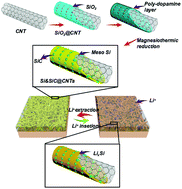A facile in situ synthesis of SiC&Si@CNT composite 3D frameworks as an anode material for lithium-ion batteries†
Abstract
SiC&Si@CNT composite 3D frameworks were successfully synthesized via an in situ reduction method of a C@SiO2@CNT precursor. Owing to the extremely large amount of heat derived from magnesiothermic reduction, SiC particles of the SiC&Si@CNT composite were obtained by a reaction between Si and C. The amount of SiC could be adjusted by changing the poly-dopamine coating time. The SiC&Si@CNT composite is composed of reduced nano Si, fine SiC and CNTs. The as-prepared materials, particularly the SiC&Si@CNT-1 sample, show superior cycling performance and electrochemical characteristics as anode materials for lithium-ion batteries. In particular, the specific capacity of the SiC&Si@CNT-1 electrode reaches 1051.44 mA h g−1 at 1 A g−1 even after 880 cycles. Furthermore, the SiC&Si@CNT-1 electrode delivered ideal reversible capacities of 671.58 mA h g−1 and 476.71 mA h g−1 at high current densities of 4 A g−1 and 8 A g−1, respectively. The porous nanostructure of the SiC&Si@CNT composite 3D framework is beneficial for shortening the path of lithium-ion diffusion inside the electrode, alleviating the volume expansion and contraction during the cycling process. These results suggest that the SiC&Si@CNT composite 3D frameworks can be used as appropriate anode materials for lithium-ion batteries.



 Please wait while we load your content...
Please wait while we load your content...